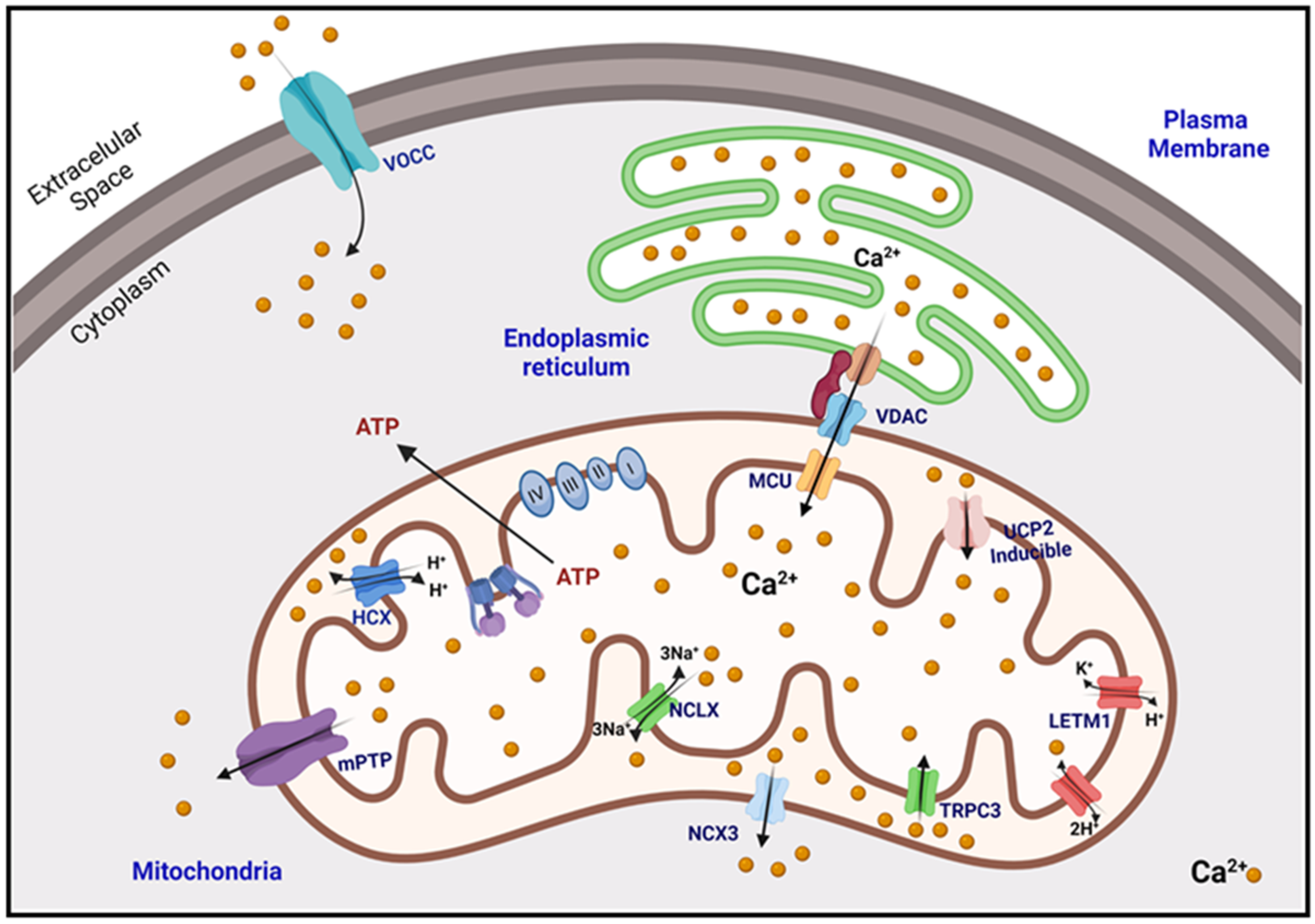Mitochondrial Calcium Ion Detection Service
Mitochondrial Calcium Ion Detection Service refers to a technical service that utilizes high-affinity, mitochondria-targeted fluorescent probes combined with platforms such as fluorescence imaging, microplate analysis, or flow cytometry to dynamically quantify and spatially analyze the concentration of free Ca²⁺ within mitochondria. This service enables real-time tracking of calcium signaling changes at the cellular or subcellular level and is widely applicable in metabolism research, cellular signaling pathway analysis, and drug screening.

Matuz-Mares D. et al. Antioxidants. 2022.
Calcium ions (Ca²⁺) are not only essential for maintaining intracellular homeostasis but also play a central regulatory role in various physiological processes, including energy metabolism, signal transduction, and apoptosis. As the core of cellular energy metabolism, mitochondria serve as the primary site for calcium storage and regulation. The influx of calcium into mitochondria can activate key enzymes in the tricarboxylic acid (TCA) cycle, thereby enhancing ATP production. However, excessive accumulation of calcium may lead to mitochondrial membrane potential collapse, increased reactive oxygen species (ROS) generation, and ultimately trigger cell death. Therefore, accurately measuring the dynamic changes of mitochondrial Ca²⁺ is crucial for understanding mechanisms of cellular regulation, disease pathogenesis, and drug action.
Leveraging advanced fluorescence imaging, microplate reading systems, and flow cytometry platforms, MtoZ Biolabs offers Mitochondrial Calcium Ion Detection Service to support the systematic analysis of calcium signaling in relation to mitochondrial function. This service is broadly applicable to studies on apoptosis, energy metabolism, neurodegenerative diseases, and pharmacological mechanism of action.
Analysis Workflow
The main workflow of Mitochondrial Calcium Ion Detection Service is as follows:
1. Sample Preparation and Staining
Select appropriate fluorescent probes based on project requirements and perform cell incubation and staining procedures.
2. Signal Acquisition
Choose imaging or flow cytometry platforms according to experimental goals to capture calcium ion fluorescence images or intensity data.
3. Data Analysis and Normalization
Calculate relative fluorescence intensity and conduct quantitative analysis normalized to cell count or protein levels.
4. Result Delivery
Provide image files, fluorescence intensity data, and a standardized analysis report.
Service Advantages
1. Advanced Analysis Platform: MtoZ Biolabs established an advanced Mitochondrial Calcium Ion Detection Service platform, guaranteeing reliable, fast, and highly accurate analysis service.
2. One-Time-Charge: Our pricing is transparent, no hidden fees or additional costs.
3. High Targeting Specificity: Utilizes mitochondria-specific fluorescent probes to minimize non-specific background interference.
4. Multi-Platform Compatibility: Supports fluorescence imaging, microplate-based detection, and flow cytometry to accommodate diverse experimental designs.
5. Experienced Team Support: Offers one-on-one technical consultation and customized solutions to ensure successful project delivery.
Sample Submission Suggestions
Sample Types: Compatible with adherent cells, suspended cells, freshly isolated cells, and other sample types.
Storage and Shipping: Cell samples should be washed with cold PBS and shipped at 4°C. Tissue sections should be fixed and transported via cold chain, avoiding repeated freeze-thaw cycles.
Additional Notes: For any questions or special sample preparation requirements, please contact the MtoZ Biolabs technical support team for customized solutions.
Applications
Application examples of Mitochondrial Calcium Ion Detection Service:
Mitochondrial Function Research
Uncover the role of calcium ions in regulating mitochondrial energy metabolism, membrane potential, and apoptotic pathways.
Cellular Signal Transduction Analysis
Investigate the regulatory mechanisms of cytosol-to-mitochondria calcium flux within signaling networks.
Drug Screening and Toxicology Studies
Evaluate the impact of compounds on mitochondrial calcium homeostasis to support candidate drug screening.
Neurodegenerative Disease Research
Explore the role of mitochondrial calcium imbalance in conditions such as Alzheimer’s disease and Parkinson’s disease.
Deliverables
1. Comprehensive Experimental Details
2. Materials, Instruments, and Methods
3. Total Ion Chromatogram & Quality Control Assessment (project-dependent)
4. Data Analysis, Preprocessing, and Estimation (project-dependent)
5. Bioinformatics Analysis
6. Raw Data Files
Related Services
Mitochondrial Analysis Services
Mitochondrial Membrane Potential Analysis Service
Mitochondrial ROS Analysis Service
How to order?







